Understanding and Addressing Fly Issues Effectively
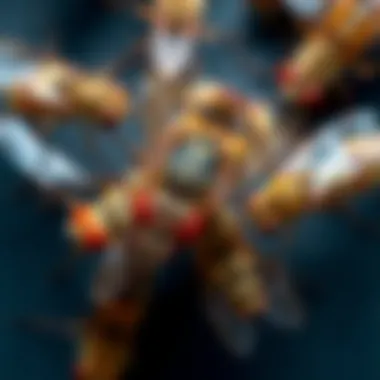
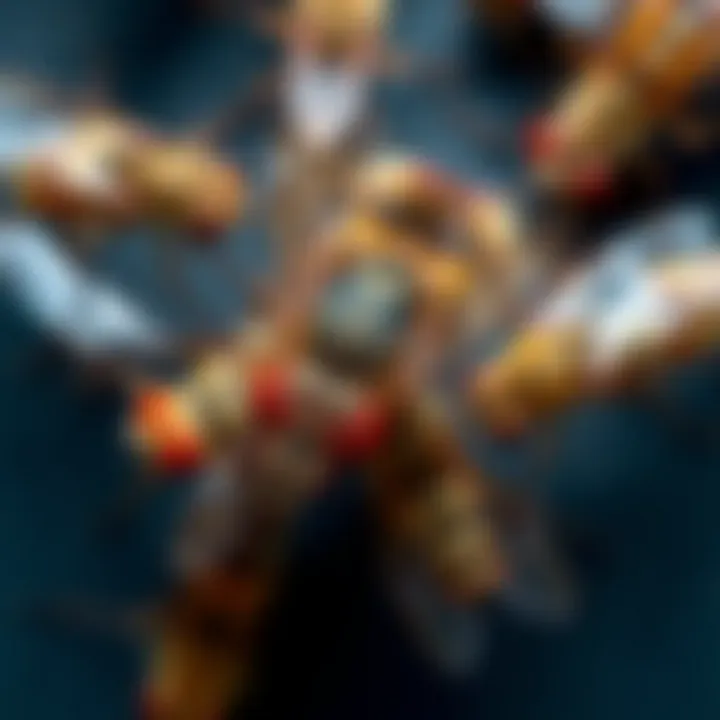
Intro
Managing fly infestations in domestic spaces is more than just a nuisance. It raises questions of hygiene and comfort. Flies, known for their rapid reproduction and adaptability, can flourish in a variety of environments, making them an ongoing challenge for many households. This guide aims to not only help you identify common types of flies but also provides insights into their breeding behaviors and the circumstances that lead to infestations.
Knowing your enemy, as they say, is half the battle. Flies can be categorized in several ways. Common household flies include the housefly, fruit fly, and drain fly, each having unique traits and behaviors. It’s crucial to not only recognize these pests, but also understand their habits. For instance, while a fruit fly may thrive on overripe fruit, the drain fly might congregate around moist areas where organic matter is decaying.
Additionally, prevention methods, DIY pest control solutions, and eco-friendly practices will be discussed to help you mitigate these issues. By the end of this article, you should find yourself equipped with valuable knowledge about flies, enabling you to devise effective strategies for management and prevention.
As we delve into the specific sections, each will be interwoven with practical advice tailored for homeowners who prioritize a clean and pest-free living space. Let's begin by understanding the signs of infestation and how to identify the nuisances that invade our homes.
Pest Identification
Common Household Pests
Flies come in different shapes and sizes, and knowing the common types residing within our households is vital for effective control. The following are some of the predominant fly species you may encounter:
- Housefly (Musca domestica): Recognizable by their grayish color and buzzing sound, houseflies are the quintessential domestic pest. They are attracted to food waste and decaying materials, posing health risks due to pathogen transmission.
- Fruit Fly (Drosophila melanogaster): These small, tan-colored flies with red eyes are often found near fruits and vegetables. They reproduce quickly and can quickly multiply if not addressed.
- Drain Fly (Psychodidae family): Often seen in bathrooms, these small, fuzzy flies thrive in moist environments like sink drains or septic systems. Their presence indicates a possible buildup of organic material.
Signs of Infestation
Recognizing the presence of flies before the infestation grows can be pivotal. Here are key signs to watch for:
- Visible Flies: The most obvious sign. If you frequently see them buzzing around food, rubbish bins, or damp areas, it's time to take action.
- Larvae: If you notice small, maggot-like larvae, it indicates that flies are breeding nearby. They can often be found in the same areas as adult flies.
- Foul Odor: A bad smell, particularly near drains or garbage, can signal decay leading to higher fly activity.
- Increased Buzzing: A noticeable increase in buzzing sounds, particularly in the summer months when flies are most active, often indicates their presence.
By keeping an eye out for these signs, you can take early action, preventing a small problem from blossoming into a larger one.
The quicker you spot and address a fly problem, the easier it will be to manage. Prevention is key, but sometimes, it starts with recognizing the threat early.
Next, we’ll explore practical prevention methods that can help maintain a fly-free environment.
The Anatomy of Fly Issues
Understanding fly issues is not just about recognizing an insect; it's about digging into the underlying factors that lead to infestations. Flies, those tiny nuisances, can be more than just a bothersome presence. They can affect cleanliness, spread disease, and disrupt the peace in a household. By examining their anatomy, we can grasp the vital aspects that contribute to effective fly management.
Understanding Fly Types
Common Flies: Characteristics and Habitats
Common flies include varieties such as house flies, fruit flies, and drain flies, each having its own unique characteristics and preferred habitats. For instance, house flies are typically found in indoor environments, thriving in places where food waste accumulates. Their notable feature is their rapid reproduction cycle, which can result in massive populations in a short time, particularly in unhygienic conditions.
This insight into the habitats and behaviors helps determine targeted strategies for management. In a household, keeping food sealed and surfaces clean can be extremely effective. On the other hand, fruit flies prefer rotting fruits and vegetables, making kitchens prime spots for infestation due to neglect of older produce.
Life Cycle of Flies: From Egg to Adult
The life cycle of flies is a critical component of understanding how quickly infestations can occur. Flies begin their lives as eggs, which can hatch within a day or two, maturing into adults in less than a week. This rapid growth can leave homeowners reeling from sudden infestations, highlighting the importance of prompt intervention.
Recognizing this lifecycle can help one devise a timely strategy for eradication. Removing potential breeding grounds, like stagnant water or decomposing matter, can cut off the supply of new flies before they emerge. In essence, understanding their life cycle allows for preemptive measures to be put in play, keeping populations at bay.
Reasons for Fly Infestations
Environmental Factors
Environmental factors play a pivotal role in fly populations. Flies thrive in warm, moist areas. Hence, settings like unclean backyards or poorly maintained kitchens can provide an ideal atmosphere for them to flourish. Understanding these conditions is key to preventing infestations.
For instance, during the summer months, the heat can accelerate breeding rates. Homeowners must remain vigilant, especially at this time of year, ensuring that habitats are less inviting for flies. Keeping the environment clean not only deters flies but also promotes overall health and hygiene in the home.
Attractants and Food Sources
Attractants take many forms, from food spills to open garbage cans. Flies are attracted to decomposing food, waste, and even pet feces. Knowing what draws these pests can empower residents to take actionable steps in their pest management strategies.
For example, sealing trash bags and keeping compost bins covered may greatly reduce the chances of a fly infestation. Additionally, even leaving food out for extended periods can serve as an open invitation to flies. By being mindful of food sources and limiting accessible attractants, homeowners can effectively mitigate the risk of infestations.
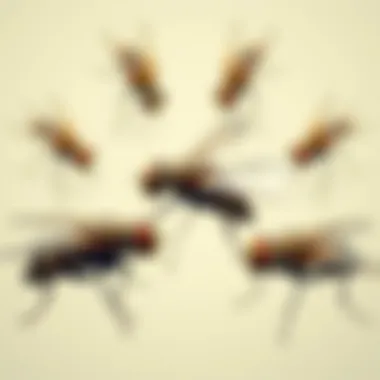
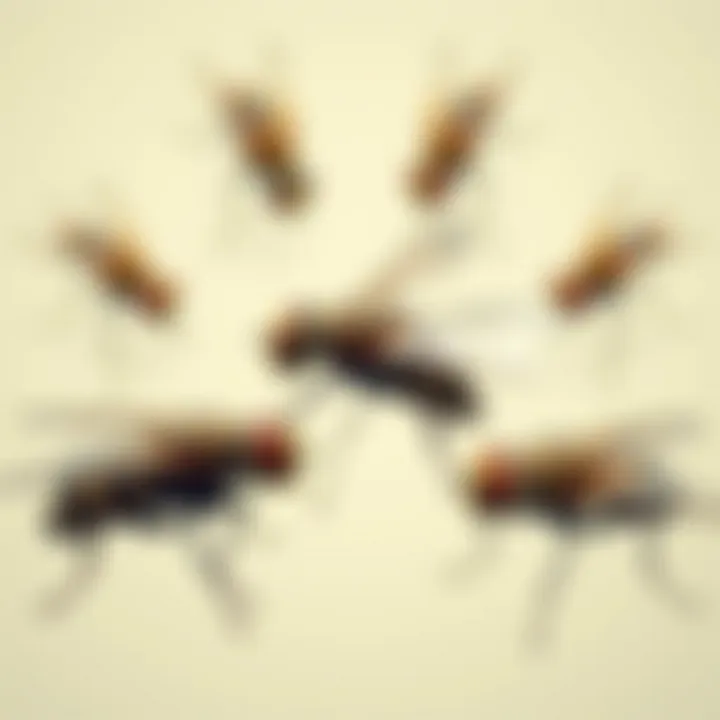
In summary, the anatomy of fly issues offers a comprehensive look into the types of flies, their life cycle, and the critical factors contributing to their presence. Armed with this understanding, homeowners can take informed action to control and manage fly populations effectively.
Identifying Fly Species
Identifying various fly species holds essential importance in managing fly-related issues effectively. Understanding the distinct characteristics and behaviors of these insects not only helps in diagnosis but also in tailoring effective control strategies. Each fly type comes with its own set of behaviors and preferred environments, which can significantly influence both prevention and extermination tactics. Homeowners can save time, effort, and resources if they can pinpoint which species they are dealing with. Furthermore, recognizing specific flies may lead to broader ecological insights, helping to maintain a balance in local ecosystems.
Common Domestic Fly Species
House Flies
House flies, commonly found buzzing around kitchens and dining areas, are notorious pests that every homeowner has likely encountered. Their ability to reproduce rapidly makes them a critical focus in pest control efforts. One key characteristic of house flies is their ability to thrive in both clean and dirty environments. They tend to breed in organic waste, which can lead to health concerns. Their presence often signifies underlying sanitation issues. House flies are unique due to their three dark stripes along their thorax and their rapid flight patterns.
The downside of house flies is their propensity to carry pathogens, making them a health risk; however, their commonality also means that there are numerous solutions available for their control. Identifying them correctly enables homeowners to take immediate action to prevent further infestations, reinforcing why they are crucial from an informative angle.
Fruit Flies
Fruit flies may be small, but they pack a punch when it comes to annoyance. These pests are frequently found hovering around ripe or decaying fruits, as well as any fermented substances. Their key characteristic is their brownish-yellow body and red eyes, which allow them to be easily identified. Fruit flies reproduce quickly; a female can lay hundreds of eggs on a piece of overripe fruit. This prolific nature can quickly lead to overwhelming infestations in kitchens.
What makes fruit flies particularly valuable in this article is their role as indicators of waste management. If you see fruit flies, it's often time to re-evaluate how food waste is stored. Besides, controlling fruit flies usually requires simple yet effective measures such as proper fruit storage, making it a practical insight for homeowners.
Drain Flies
Drain flies, often mistaken for moths, are typically found in areas where moisture accumulates, such as sinks and drains. One key feature of drain flies is their distinctive furry appearance and their slow, hovering flight. Unlike other flies that are constantly on the go, drain flies have a more subdued behavior. Their breeding habits usually involve laying eggs in organic matter within the drains, creating an additional challenge for homeowners.
Identifying drain flies is beneficial because it offers clues about plumbing issues or stagnant water in the home. Recognizing the presence of drain flies means one should consider inspecting drains and cleaning them to eliminate not just the pests but also the source of attraction. Their unique lifestyles make them a critical topic in achieving holistic home management.
Identifying Lesser-Known Flies
Fly Behavior Patterns
Understanding fly behavior patterns offers crucial insights for effective fly management. Recognizing how flies move and where they typically congregate can be illuminating. For instance, house flies prefer warm environments, especially near sources of food. They tend to rest in shaded areas during parts of the day. Spotting these behaviors helps in predicting their patterns and targeting solutions effectively.
Notably, the behavior of different fly species can vary significantly, making it vital for homeowners to learn about these variations. Keeping an eye on flying habits informs homeowners on the best times for fumigation or trapping, thereby enhancing pest control strategies.
Utilizing Traps for Identification
Utilizing traps is an effective method for identifying specific fly species. There are various traps available, ranging from simple sticky traps to more complex pheromone lures designed to target specific flies. An important characteristic of traps is that they serve dual purposes; they not only capture flies but also offer insights into their species based on the captured specimens.
Employing this technique can be particularly beneficial for addressing lesser-known fly species that homeowners may encounter. Identifying the captured flies can lead to tailored solutions unique to the species in hand. Utilizing traps provides an evidence-based approach to tackling the issues related to fly infestations.
In summary, identifying fly species is a fundamental aspect of controlling infestations effectively. Recognizing both common and lesser-known flies paves the way for strategic pest management methods, ultimately leading to a healthier living environment.
By understanding the diverse types of flies and their habits, homeowners and pest control professionals alike can enhance their approaches and create targeted strategies for fly management.
For further details, you can check resources like Wikipedia or Britannica.
Understanding Fly Behavior
Understanding fly behavior is crucial when tackling the issues they present in our homes. Flies are not just mere nuisances; their behavior significantly influences the success of pest management strategies. By grasping the dynamics and intricacies of fly feeding and reproductive habits, individuals can take early preventive measures to deter infestations, ultimately leading to a cleaner and more pleasant living environment.
Flies are attracted to certain foods and environments, and their life patterns can shed light on how to effectively deal with them. Recognizing these behaviors allows homeowners to adjust their habits and environments in ways that minimize attraction and proliferation. Moreover, knowledge of fly behavior can aid in the selection of appropriate control methods, ensuring a more effective approach to managing these pests.
Feeding Habits and Food Preferences
Nutritional Needs
Flies have peculiar nutritional needs that directly impact their attraction to human habitats. Most flies, such as house flies, thrive on sugary substances, fermented foods, and other organic materials. This preference stems from their need for carbohydrates, which provide energy crucial for their short lives.
For instance, house flies often flock towards overripe fruits or spilt sodas. Their keen sense of smell enables them to detect these food sources from a distance. By providing detailed knowledge on these preferences, readers can adjust their kitchens and eating areas by keeping food tightly sealed and promptly cleaning up spills. One particular advantage of understanding nutritional needs is that it empowers individuals to create barriers against flies by simply managing food sources more effectively.
Impact of Decaying Matter
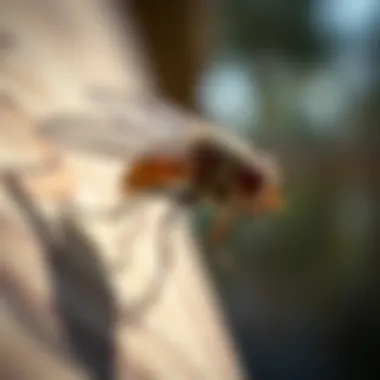
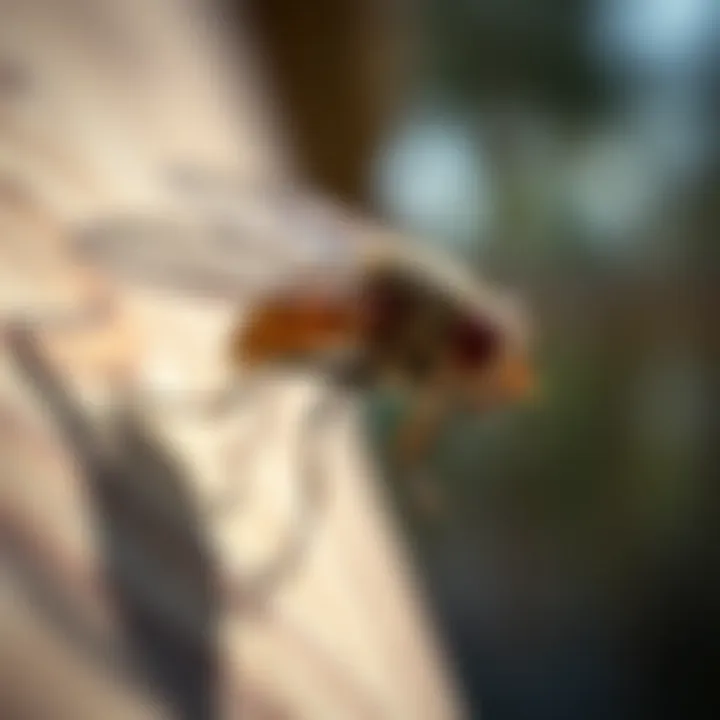
Decaying organic matter acts as a beacon for various fly species. The breakdown of leftovers, decomposing fruits, or even compost can release odors that attract flies looking for a suitable environment to feed and breed. The correlation between decaying matter and fly activity underscores the importance of sanitation in fly management.
For many homeowners, recognizing this impact means understanding the need for regular waste disposal and cleaning of surfaces. Not only does it minimize a fly’s food source, but it also promotes overall hygiene in the kitchen and surrounding areas. A unique feature of dealing with decaying matter is the proactive approach one can take: by composting thoughtfully and being diligent about decay, the attraction of flies can be significantly reduced while enhancing one’s gardening efforts.
Breeding and Reproduction
Ideal Conditions for Breeding
Flies need specific conditions to breed effectively. Warm temperatures, moisture, and abundant food sources create an ideal breeding ground. For instance, house flies can reproduce rapidly in conditions between 75-90°F and in wet areas where organic waste accumulates. Recognizing these conditions can offer homeowners a chance to disrupt the fly life cycle even before an infestation begins.
Understanding these ideal breeding circumstances allows homeowners to target problem areas. Proper ventilation and regular cleaning can deter these reproductive activities. The advantage of identifying these conditions is twofold: it prevents fly infestations and enables more environmentally-friendly management strategies.
Egg Laying Patterns
The egg-laying patterns of flies reflect their adaptability in seeking out optimal environments for procreation. Female flies typically lay hundreds of eggs at once, often near potential food sources for their larvae. This behavioral trait emphasizes the urgency homeowners face when noticing fly presence; even a small number of flies can signify a forthcoming problem.
Being aware of these patterns is beneficial because it allows for timely interventions. Homeowners can identify spots where flies tend to lay eggs, such as damp dishrags or garbage bins. Proactive approaches to sanitation, such as regularly checking waste areas and cleaning surfaces, can make a world of difference in preventing infestations. Recognizing the significance of egg-laying habits translates to more effective pest management, saving time and effort in the long run.
Incorporating knowledge of fly behavior into daily routines fosters a comprehensive approach to pest management. By understanding their feeding habits, breeding conditions, and egg-laying tendencies, individuals can actively engage in preventing and controlling fly infestations.
Fly Control Techniques
Effectively managing fly populations requires a keen understanding of the control techniques available. These techniques are essential in maintaining a fly-free environment within the home and entail a combination of preventive measures, DIY solutions, and professional services. By employing a multi-faceted approach, homeowners can significantly reduce the likelihood of infestations and address existing problems promptly. Each strategy offers unique benefits and considerations, promoting a holistic perspective towards fly management.
Preventive Measures in the Home
Proper Sanitation Practices
Proper sanitation practices form the backbone of any effective fly control strategy. Keeping living spaces clean and free of debris not only makes the environment less appealing to flies but also disrupts their breeding habitats. Regularly tidying up areas where food is prepared or consumed is crucial. This means promptly cleaning spills, covering trash bins tightly, and avoiding food debris on countertops. One key characteristic of this practice is its cost-effectiveness; it requires minimal investment aside from time and effort.
One of the unique features of maintaining good sanitation is that it addresses the root cause of infestations rather than just the symptoms. However, it’s worth noting that some residents may find this labor-intensive, especially in larger households. Yet, the long-term benefits far outweigh the drawbacks, as consistent cleanliness can substantially reduce fly populations over time.
Managing Waste Effectively
Managing waste effectively is another critical aspect of fly prevention. By ensuring that waste is disposed of properly and regularly, homeowners can cut off potential breeding grounds for these pests. This involves not just the timely collection of garbage but ensuring that organic waste is sealed and stored away adequately.
The primary characteristic of effective waste management is that it involves a systematic approach to refuse. Utilizing sealed containers can keep odors contained and discourage flies from attracting to the area. One unique feature of this strategy is its impact on the overall cleanliness and health of the home. Nonetheless, some may find it challenging to keep track of waste disposal schedules, leading to potential lapses that can invite flies back. Setting reminders or utilizing delivery services can mitigate this issue and enhance effectiveness.
DIY Solutions for Fly Management
Natural Repellents
Natural repellents are increasingly popular among homeowners looking for chemical-free solutions. Many common household ingredients, such as vinegar or essential oils, can deter flies effectively. Their contribution to the overall goal of fly management lies in the safe and eco-friendly approach they promote without harsh chemical residues in living spaces.
A key characteristic of natural repellents is that they are often readily available in most kitchens, making them a convenient choice. This aspect means that homeowners can quickly whip up a repellent without additional costs. However, while effective, these solutions may require frequent reapplication, especially if subjected to moisture or cleaning. Balancing their use with other solutions can maximize their efficacy.
Effective Traps
Effective traps serve as practical tools in reducing fly numbers. Various designs are available, from sticky traps to electric fly zappers, each capturing flies in different ways. By employing traps, homeowners can proactively catch existing flies, thereby preventing them from multiplying. The primary characteristic of these traps is their ease of use; they require little setup and can immediately start working upon installation.
A unique aspect of using traps is that they can double as monitoring tools, allowing homeowners to gauge the severity of infestations. The downside is that traps need to be emptied or replaced regularly to remain effective, which might burden some households. Yet, they serve as a visual reminder of fly presence, prompting timely interventions if numbers begin to rise.
Professional Pest Control Options
Chemical Control Methods
While DIY solutions have their merits, some infestations may require the expertise of professionals. Chemical control methods are robust options that can address severe fly issues efficiently. These methods often involve insecticides specifically designed for flies and their life cycles. The key feature of chemical control is its potency; these products can rapidly reduce fly populations when applied correctly.
However, such methods come with considerations regarding safety and environmental impact. Homeowners need to be cautious, especially if children or pets are present. Balancing the effective use of chemicals with safety protocols is essential to ensure that the household remains protected during and after treatment.
Integrated Pest Management (IPM)
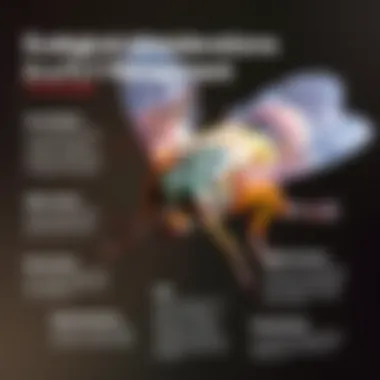

Integrated Pest Management (IPM) is an environmentally sensitive approach that combines various control measures for a more sustainable solution. IPM not only considers chemical methods, but also incorporates biological and cultural practices tailored to the specific fly species present. The primary characteristic of IPM is its holistic approach, aiming for long-term solutions rather than quick fixes.
A unique aspect of IPM is that it empowers homeowners to understand their pest problems better and engage with solutions reactively. However, implementing an IPM program may require some initial investment in time or resources for proper training and understanding. Once established, it can lead to sustained management of pests without overly relying on harsh chemicals, making it a responsible choice for fly control.
Ecological Considerations
Understanding ecological considerations is crucial when addressing fly issues. It highlights the intertwined relationship between flies and their environment, and this perspective is necessary to not only combat infestations but also to maintain ecological balance. Managing fly populations involves taking into account their roles in ecosystems, which makes the control methods more effective and sustainable in the long run.
Impact of Flies on Ecosystems
Role in Decomposition
Flies are often viewed as nuisances, but their role in decomposition is vital for many ecosystems. They help break down organic matter, including dead animals and decaying vegetables. This process recycles nutrients back into the soil, promoting healthy plant growth. Without flies, we would face a build-up of waste, potentially leading to unsanitary conditions and disrupted ecological systems.
One key characteristic of flies in decomposition is their ability to reproduce rapidly, which ensures that they can respond quickly to available organic material. This swift action helps to accelerate decomposition, which benefits soil health.
Another unique feature of this process is that it attracts other animals, like birds and other insects, promoting biodiversity in a localized area. However, relying only on flies for waste disposal has its disadvantages, such as their potential to spread pathogens in certain settings. Understanding this balance is vital when considering eco-friendly ways to manage fly populations.
Food Source for Other Species
Flies also contribute significantly to the food chain. Many species, from birds to mammals, rely on flies as a food source. This makes them an essential element in maintaining the food web. Their abundance can sustain various insectivorous creatures, ensuring stability in local ecosystems.
The main characteristic of flies as a food source lies in their high protein content, making them an ideal meal for vulnerable species, especially in environments where other food sources are scarce.
An interesting aspect here is that their populations can fluctuate, which may impact predators dependent on them, potentially causing imbalances. For example, if fly populations surge, predators might thrive, but a subsequent decline could lead to food shortages for those predators.
Sustainable Pest Management Practices
Organic Control Methods
Adopting organic control methods is a progressive step towards sustainable pest management. This approach leverages natural solutions rather than chemical pesticides, prioritizing the health of both the environment and human beings. Organic methods often include things like beneficial insects, natural repellents, and habitat enhancement to minimize fly populations.
A defining characteristic of organic control methods is their compatibility with environmental health. They not only address the immediate fly issues but also contribute to long-term ecosystem welfare. By fostering a balanced environment, home and property owners can enjoy reduced fly presence, while supporting the local fauna.
However, organic methods can take longer to yield results compared to traditional chemical solutions. Homeowners may need to exercise patience and sustain efforts over time, yet the long-term ecological benefits often outweigh these initial drawbacks.
Long-Term Strategies for Success
When managing flies, long-term strategies are essential for tackling infestations effectively. This involves understanding and anticipating future fly populations, rather than just responding to current outbreaks. Building a more resilient environment means investing efforts in fly-proofing homes by sealing entry points, maintaining cleanliness, and managing waste efficiently.
The essential characteristic of long-term strategies lies in their proactive approach. Instead of merely dealing with the consequences of fly presence, effective management focuses on prevention. This reduces reliance on reactive measures over time.
Additionally, long-term strategies can be adapted to changing conditions, benefiting from innovations in sustainable practices. Yet, homeowners need to actively participate in these practices, as simply adopting a long-term strategy without ongoing commitment can lead to failure in achieving desired results.
Understanding ecological considerations not only informs better pest management but also aligns our efforts with the overarching goal of fostering a balanced natural world. Educating yourself on the roles flies play in ecosystems can help you appreciate their value beyond just being pests.
Ending: A Holistic Approach to Fly Management
Addressing fly issues requires a perspective that goes beyond mere pest control. It's essential to adopt a holistic view of how flies interact with environments and the responsibilities we hold as homeowners. Equipping oneself with knowledge and understanding is not just beneficial; it’s crucial. A multifaceted approach is needed for effective management, combining prevention, education, research, and sustainable practices.
Ultimately, the goal is to harmonize our living spaces with nature, rather than impose control in a manner that causes disruption.
The Importance of Education
Staying Informed About Flies
To tackle fly infestations efficiently, staying informed is paramount. This means understanding the various fly species, their life cycles, and their habits. Knowledge equips homeowners with the power to spot potential problems before they escalate.
A key characteristic of staying informed is the continued rate of change in how pest management is perceived. With plenty of resources available, ranging from educational blogs like Entomology Today to community workshops, it can be a beneficial choice for anyone wanting to improve their pest control strategy. The unique feature of remaining updated about flies entails not just awareness, but also the capability to implement proactive measures. The benefits include reduced infestations and enhanced home comfort. Conversely, neglecting this aspect could lead to chronic issues that become increasingly harder to tackle.
Continuous Learning in Pest Management
Continuous learning plays a significant role in effective pest management. Just as flies evolve, so should our strategies. The pest control landscape is constantly shifting due to advancements in science and technology. Homeowners who engage with educational platforms can adapt their methods accordingly, ensuring they are using the most current and effective techniques available.
The key characteristic here is the dynamic nature of knowledge in pest management, as resources become more accessible online. This is valuable as it fosters an environment where experience and new information can be shared widely. Continuous learning creates a community among homeowners and professionals, making it easier to tackle collective issues. On the downside, not everyone may have the time or inclination to invest in ongoing learning, which could hinder their effectiveness in addressing fly issues.
Future Directions in Fly Control Research
Innovations in Pest Control
In recent years, there has been a marked shift toward innovative pest control strategies. Ecologically considerate methods are gaining traction, driven by a growing awareness of sustainability and environmental health. These innovations range from pheromone traps to biodegradable insecticides, which contribute to less environmental impact while still effectively managing fly populations.
The primary characteristic of these innovations lies in their adaptability; they often cater to specific needs, making them more effective than traditional methods. This flexibility is a popular choice that addresses not only the issue of flies but also the concerns of eco-conscious homeowners. However, the challenge can be the priciness of some of these advanced solutions, making them less accessible to all.
Enhancing Integrated Approaches
Enhancing integrated approaches to fly control weaves together various techniques, both old and new. This can include combining chemical controls with biological methods, such as releasing natural predators in the environment. Such integration amplifies the effectiveness of pest control strategies, ensuring long-term sustainability and efficiency in managing fly populations.
A defining characteristic of integrated approaches is their comprehensive nature, as they address multiple facets of fly management. This can easily become a desired option for those looking to mitigate not just the immediate problems, but also underlying issues contributing to infestations. The downside, however, is that it requires careful planning and coordination, which may be challenging for some homeowners attempting a DIY approach.















